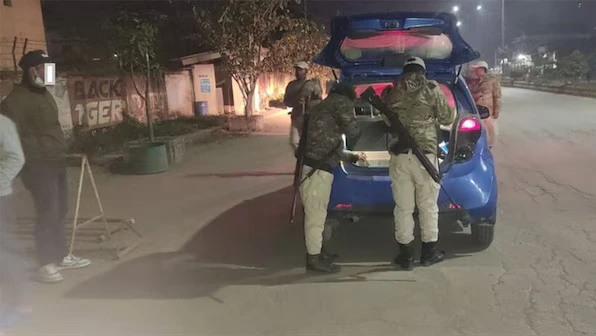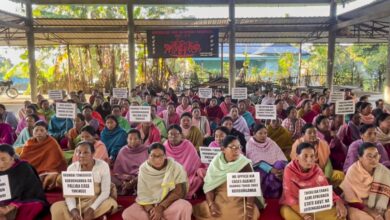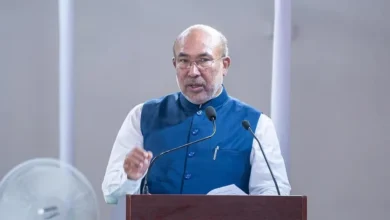Santa will visit the hills of Manipur, and on Christmas Day, church bells will ring. As carols fill the midnight air between December 24 and 25, the people of Manipur—both in the hills and the plains—will celebrate the birth of Jesus Christ. But amid the prayers, one question remains: Will peace ever return to the land of the Meiteis, Kukis and the majestic Sangai?
Peace in Manipur is as delicate as navigating Loktak Lake, the largest freshwater lake in northeastern India, with its phumdis—floating masses of plants and soil. These phumdis drift with the wind and currents, making boating unpredictable and risky. Similarly, peace here is fragile, always at the mercy of shifting tensions.
Since May 2023, this fragility has deepened, with even a small spark threatening to ignite a larger conflict. While Christmas prayers will bring hope for a peaceful 2025, the events of 2024 offer little comfort. From weaponised drones to violence against life, property and law, Manipur feels trapped in chaos—far from the elegance of its classical dance Manipuri, which symbolises harmony and grace.
Elections and the elusive political balm
With growing dissatisfaction among the people in both the hills and plains of Manipur toward the BJP, the Congress’ big win in the May 2024 Lok Sabha elections wasn’t a surprise. Congress won both seats in the state. Angomcha Bimol Akoijam of Congress defeated BJP’s Thounaojam Basant Kumar Singh by over 1.09 lakh votes in the Inner Manipur constituency. In the Outer Manipur constituency, Alfred Kanngam S Arthur won by more than 85,000 votes against Kachui Timothy Zimik from the Naga People’s Front.
The elections were held amid ethnic tensions between the Kuki-Zo and Meitei communities. Both the BJP and NPF contested one seat each, facing Congress in both constituencies. This was a change from the 2019 elections when BJP and NPF won one seat each, and from 2014 when Congress held both.
But did this shift in political power lead to peace? Sadly, it did not. May 2024 marked not only the elections but also one year of continuous violence and protests in Manipur—a painful chapter in the state’s history. Government records show shocking figures: 4,786 houses destroyed, 386 religious structures damaged, over 250 lives lost, and at least 60,000 people displaced due to the clashes between the Meitei community and the Kuki-Zo tribes.
Today, the state remains divided into two ethnic zones—one controlled by the Meiteis and the other by the Kuki-Zo.
No temporary solution
The Manipur government appears to be working on quick-fix solution to a complex issue, leading to contrasting demands from the two sides of the ethnic divide. In March this year, the government deported 77 immigrants from Myanmar, including 38 on a single day through the Moreh border check post. While this was a positive move, it didn’t bring much relief to the Meitei community, which had raised concerns about the arrival of Myanmar refugees since 2021. The region was peaceful for a few months during the monsoon rains, but that fragile peace was broken when bombs were dropped from drones, shattering the calm.
Deadly drones
On September 1, the fragile peace in Manipur was shattered by a drone attack in Koutruk, Imphal West, ending a three-month break in violence. The attack, from neighbouring Kangpokpi district, killed two and injured nine, highlighting the divide between the Meitei-majority plains and the Kuki-dominated hills.
The next day, another drone strike in Senjam Chirang left three injured, while armed assailants stole weapons from a security post in Sagolmang, Imphal East. On September 6, rockets were fired into Bishnupur, killing one.
A video surfaced showing Kuki-Zo militants threatening Meitei fighters to vacate certain areas within three days. The police called the drone attacks “unprecedented,” suggesting involvement of skilled professionals using drones to escalate the violence.
Weaponised drones, capable of carrying grenades and mortar bombs, have become deadly tools in the conflict. In response, the government deployed an anti-drone system, Dronaam, to combat this new threat.
Preacher or predator?
In a separate, deeply troubling twist, American evangelist Daniel Stephen Courney, a 40-year-old missionary, has ignited controversy after a video emerged showing him distributing military-grade equipment to Kuki militants in Manipur. The footage, uploaded in March on his YouTube channel Fool for Christ, depicts him handing out drones, bulletproof vests, boots and socks—purportedly to aid “Kuki civilians” but with clear implications for escalating the conflict.
Such actions blur the lines between missionary work and active involvement in an already fraught ethnic conflict. The fact that he remains unaccountable for distributing military-grade items that contribute to the chaos in a state desperate for peace only deepens the unease. Why has he not been held accountable for intensifying tensions in a region already parched for harmony?
November pains
Manipur, a state enchanted by K-pop’s rhythm, now finds an unsettling resonance in the poignant lyrics of Guns N’ Roses’ November Rain:
So never mind the darkness
We still can find a way
‘Cause nothin’ lasts forever
Even cold November rain
November’s darkness descended with brutal force when a 31-year-old Kuki woman was found burned to death in a village in Jiribam district on November 7. Just days later, on November 11, violence escalated dramatically as 10 armed Kuki men were killed in a gunfight with security forces. The clash erupted when they allegedly attempted to attack a police station and a nearby CRPF camp. Amid the chaos, a Meitei family of six went missing, adding to the growing shadow of despair.
On November 17, defying curfew orders, hundreds staged demonstrations across Manipur. The unrest led to the arrest of 23 individuals for acts of violence, as the fragile peace between the two ethnic communities unravelled further.
The Assam Rifles, in a statement on November 11, revealed extensive operations in both the hill and valley regions to confiscate illegal weaponry. Their haul included .303 rifles, pistols, grenades and even projectile launchers. Reinforcements arrived as the operation continued late into the night, recovering AK-series and INSAS rifles from the conflict zones.
Grieving the loss of what they described as “village volunteers” defending their communities, Kuki-Zo organisations called for a total shutdown in hill areas on November 12, from 5 am to 6 pm, highlighting concerns over civilian safety amid intensifying ethnic tensions.
To stabilise the situation, security forces ramped up their presence, deploying additional teams from the CRPF and Assam Rifles to maintain order in violence-affected areas. The Ministry of Home Affairs responded swiftly by deploying 20 more companies of Central Armed Police Forces (CAPF) to Manipur. This brought the total number of CAPF units in the state to 218, an urgent measure aimed at curbing the persistent ethnic violence tearing through the region.
December descends
As Manipur grapples with the aftermath of ethnic violence, new findings have deepened the state’s security concerns. Following the recent use of weaponised drones, a joint operation by the army and security forces in Imphal East uncovered items that have stirred speculation and alarm. Among the recovered items were an internet satellite antenna and a router bearing the “Starlink” logo, raising questions about the potential misuse of advanced technology in the conflict-ridden state.
On December 13, Manipur Police posted photographs of the seized items on X, showcasing the satellite devices recovered during the operation in Keirao Khunou. The same images were later shared by the Army’s Spear Corps. Observers were quick to connect the dots with one X user addressing Elon Musk directly. Despite Musk’s assurance, the presence of devices branded with the Starlink logo has sparked debate.
The seized items, reportedly linked to the banned insurgent group Revolutionary People’s Front/People’s Liberation Army (RPF/PLA), included more than just satellite devices. The cache also contained an MA4 assault rifle, a 12-bore single-barrel gun, pistols, grenades and 5.56mm ammunition.
Amid these unsettling developments, Supreme Court is pressing the Manipur government for accountability regarding damages caused during the ethnic violence earlier this year. On December 9, a bench led by Chief Justice Sanjiv Khanna and Justice Sanjay Kumar directed the state to submit detailed reports on residential and commercial properties that were destroyed or encroached upon.
The bench also sought a comprehensive account of actions taken against individuals responsible for arson and encroachment. The next hearing, scheduled for January 2025, will likely delve into the measures adopted by the state to address the grievances of affected communities and ensure justice.
Genesis of the violence
As 2025 approaches, Manipur stands at a crossroads. The question remains whether the coming year will heal its wounds or deepen its divides. For now, the midnight prayers carry a fragile hope—one that the new year might finally usher in the peace that eluded 2024.
Manipur’s story in 2024 is one of pain and perseverance, division and resilience. It is a tale that demands reflection, not just by its people but by the entire nation. For only through understanding can the hope of reconcilliation become a reality. The turmoil in 2024 does bring to mind the wistful lyrics of the Christmas classic Last Christmas:
Last Christmas, I gave you my heart,
But the very next day, you gave it away.
One can’t help but wonder—was the “heart” ever truly offered, or was it just another illusion lost amid the bitterness of fractured unity?
Source: First Post





